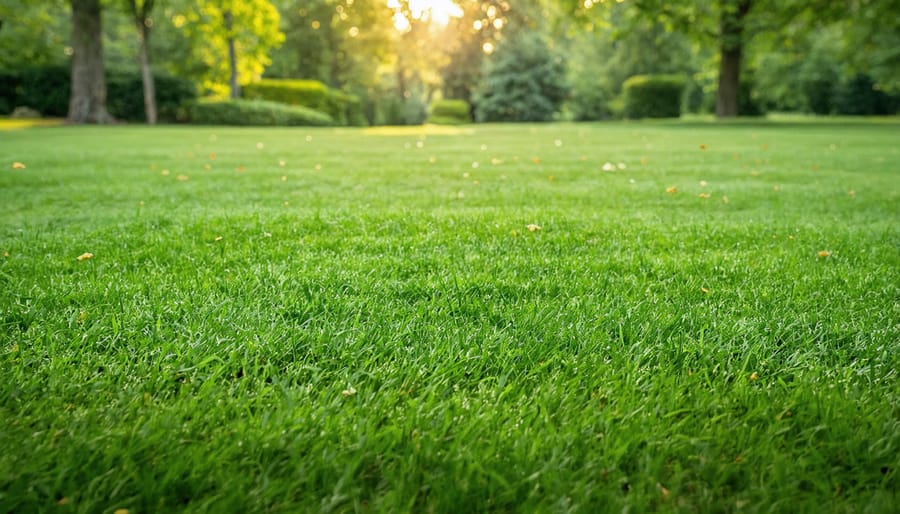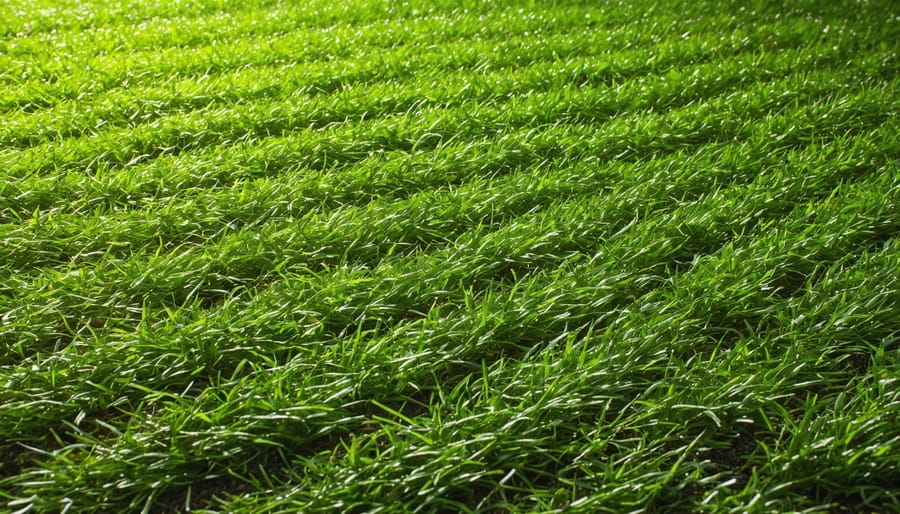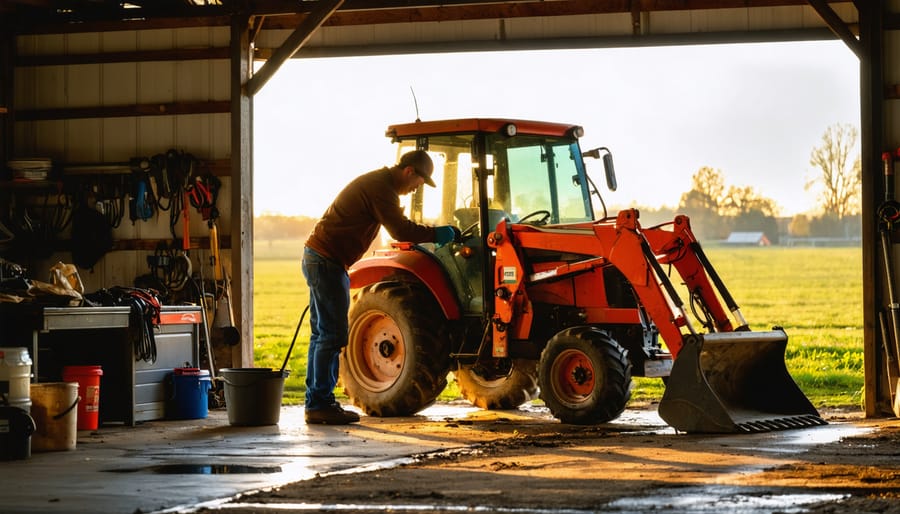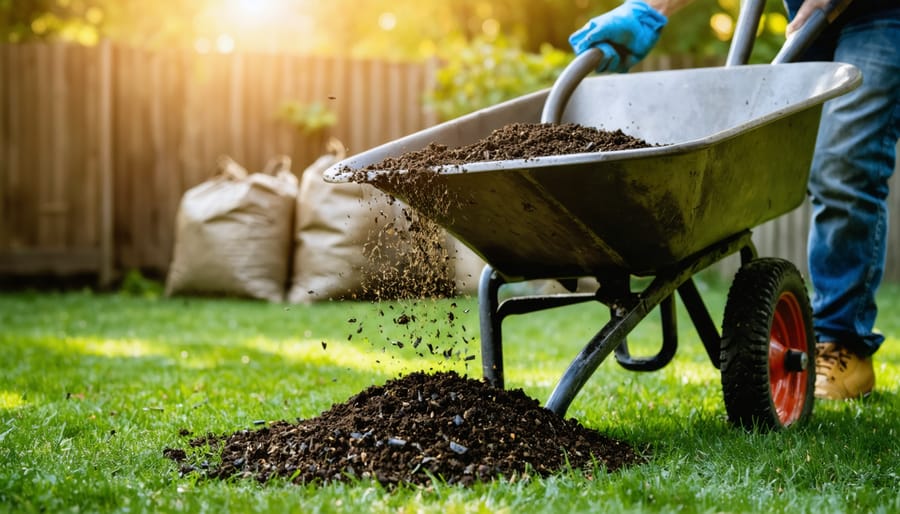Fall reseeding transforms tired, patchy lawns into lush green carpets by working with nature’s perfect conditions rather than against them. Between late August and mid-October, cooler air temperatures combined with warm soil create an ideal environment where grass seed germinates quickly, establishes deep roots, and faces minimal competition from weeds. This seasonal advantage means your investment of time and seed pays off with thicker, healthier turf that’s better equipped to handle next summer’s heat and foot traffic.
The process succeeds because fall’s morning dew keeps seeds consistently moist while moderate temperatures prevent the scorching that dooms spring seeding efforts. Weed pressure drops dramatically as crabgrass and other annual invaders die off, giving your new grass seedlings the breathing room they need to establish themselves. You’ll also appreciate that fall reseeding requires less frequent watering than spring attempts, since autumn rains often handle much of the work for you.
Whether you’re filling bare patches, thickening thin areas, or completely renovating a neglected lawn, fall offers a forgiving window where even beginners see professional-quality results. The cool-season grasses most homeowners plant—fescues, ryegrass, and Kentucky bluegrass—are biologically programmed to thrive during this season, making your timing as important as your technique. With proper preparation and consistent aftercare through winter, you’ll watch your reseeded lawn emerge from spring dormancy dense, vibrant, and resilient enough to become the neighborhood standout.
Why Fall Is Nature’s Perfect Window for Reseeding

The Temperature Sweet Spot
Fall creates a goldilocks zone for grass seed—not too hot, not too cold, but just right. While spring seeding challenges include battling weeds and unpredictable weather swings, autumn offers stable conditions that seedlings love.
The magic happens when soil temperatures sit between 50-65°F and air temperatures hover around 60-75°F during the day. These conditions typically arrive in mid-September through mid-October for most northern regions. You can check your soil temperature with an inexpensive thermometer—just push it two inches into the ground around mid-morning for an accurate reading.
Here’s why this temperature range works beautifully: cool air slows top growth just enough to prevent leggy, weak blades, while the still-warm soil encourages robust root development. Your grass essentially focuses its energy downward, building a strong foundation before winter arrives. Meanwhile, germination happens reliably within 7-21 days, depending on grass type.
This underground activity continues even after your lawn stops growing visibly, giving new grass a secret head start that spring-seeded lawns simply cannot match. By the time winter arrives, your seedlings have established deep roots ready to explode with growth come spring.
Weed Competition Takes a Holiday
Here’s a bonus that makes fall reseeding even more appealing: nature does some of your weed control work for you. As temperatures drop, many troublesome annual weeds like crabgrass, foxtail, and chickweed naturally die off. These warm-season invaders that plagued your lawn all summer simply can’t survive the approaching frost.
This seasonal shift creates a perfect window for your new grass seed to establish without competition. Think of it as giving your grass seedlings a head start in a race where most of their opponents don’t even show up. Without aggressive weeds hogging moisture, nutrients, and sunlight, your grass can focus all its energy on developing strong roots.
Another sustainable advantage? You won’t need to apply pre-emergent herbicides that can interfere with seed germination. Since the weeds are already retreating, you can skip the chemicals entirely. This means healthier soil biology, better water absorption, and a more environmentally friendly approach to lawn renovation.
The cooler fall weather also slows down any perennial weeds that remain, making them less aggressive competitors. Your new grass gets the breathing room it needs to become well-established before any serious weed pressure returns next spring. It’s one of nature’s gifts to the mindful gardener.
Reseeding vs. Overseeding: Choosing Your Approach
When to Completely Reseed
Sometimes overseeding just won’t cut it, and your lawn needs a complete do-over. If more than 50% of your lawn consists of bare patches or weeds, complete reseeding is your best path forward. Severely damaged lawns from drought stress, heavy foot traffic, or neglect benefit from starting fresh rather than patching problem areas.
Disease or pest destruction often leaves lawns beyond simple repair. If grubs, fungal infections, or other issues have decimated your grass, complete reseeding allows you to address soil health issues and choose disease-resistant varieties suited to your region.
Post-construction scenarios almost always require full reseeding. Compacted soil, removed topsoil, and construction debris create challenging conditions where existing grass struggles to recover. These situations give you the perfect opportunity to establish proper drainage, amend soil thoroughly, and create the lawn you’ve always wanted.
While complete reseeding requires more effort and patience than overseeding, fall’s ideal growing conditions help new grass establish quickly. You’ll invest more upfront, but you’re building a healthier, more resilient lawn from the ground up—a sustainable approach that pays dividends for years to come.
When Overseeding Is Your Best Friend
Overseeding is like giving your lawn a refreshing boost rather than a complete makeover. It’s perfect when your grass is basically healthy but needs a little help looking its best. Think of those areas where the turf has become slightly thin over the summer, where you can still see decent grass but also more soil than you’d like. Overseeding fills those gaps beautifully without the labor-intensive process of starting from scratch.
If you’ve got minor bare patches scattered across your yard, overseeding works wonders. It’s also your go-to solution for improving grass variety—maybe you want to introduce newer, more drought-resistant cultivars alongside your existing lawn. Many experienced gardeners make overseeding part of their annual fall routine, ensuring their lawns stay thick and resilient year after year. This proactive approach prevents weeds from taking hold and maintains that lush appearance we all love. When your lawn just needs a pick-me-up rather than emergency intervention, overseeding delivers practical, sustainable results.
Preparing Your Lawn: The Foundation of Success
Mowing and Clearing: Setting the Stage
Before you scatter a single seed, you’ll need to prepare your canvas. Think of it like setting up for a painting—the better your prep work, the more stunning your results. Start by mowing your lawn shorter than usual, cutting down to about 1.5 to 2 inches. This might feel a bit drastic if you’re used to keeping grass taller, but trust me, it’s essential. Shorter grass allows new seeds to reach the soil instead of getting trapped in a dense canopy where they’ll dry out or get eaten by birds.
After mowing, take time to remove any debris—leaves, sticks, dead grass clippings—anything that creates a barrier between seed and soil. A good rake works wonders here, and you’re doing double duty by loosening the top layer of soil slightly. This isn’t about perfection, but about creating those crucial points of contact where seeds can nestle into the earth and begin their journey. Remember, successful germination depends on seeds touching soil directly, so every bit of clearing you do now pays dividends later.
Soil Testing and Amendment
Before you scatter a single seed, take time to understand what’s happening beneath your lawn’s surface. A simple soil test—available through your local extension office or with an at-home kit—reveals your soil’s pH level and nutrient profile. Most grass species thrive in slightly acidic soil with a pH between 6.0 and 7.0. If your results fall outside this range, you’ll struggle to establish healthy grass no matter how carefully you seed.
Testing also identifies nutrient deficiencies that amendments can correct. Low pH? Add lime to raise it gradually. Too alkaline? Sulfur brings it down. These adjustments take time to work, so applying them before reseeding gives your soil chemistry a head start.
Beyond pH correction, enriching your soil with organic matter creates the foundation for long-term lawn health. Compost is my go-to amendment—it improves soil structure, enhances water retention, and feeds beneficial microorganisms. Spread a quarter-inch layer across your prepared lawn and work it into the top few inches of soil. This sustainable approach reduces your reliance on synthetic fertilizers while building resilient soil that supports strong root development.
Pair your amendments with appropriate fall fertilization to give new seedlings the nutrients they need during their critical establishment phase.

Aeration and Dethatching: Opening the Door
Before your grass seed can truly thrive, you need to give it direct access to the soil. That’s where aeration comes in—and it’s a game-changer for fall reseeding success.
Aeration creates small holes in your lawn, breaking through compacted soil that acts like a barrier to seed germination. When soil is compacted from foot traffic or heavy clay content, seeds can’t make proper contact with the earth below. Those tiny holes allow seeds to nestle into the soil, access moisture and nutrients more effectively, and establish robust root systems. Think of it as opening windows in a stuffy room—suddenly everything can breathe.
For most lawns, core aeration (which removes soil plugs rather than just poking holes) works best and should be done just before reseeding. You’ll find various options for getting this done, from manual aerating tools suitable for small patches to gas-powered machines for larger areas. Many hardware stores offer equipment rentals if you prefer a DIY approach, though we regularly review both rental and consumer lawn care equipment to help you choose wisely.
Dethatching addresses a different issue—removing the dense layer of dead grass and organic matter that accumulates between soil and living grass. If your thatch layer exceeds half an inch, dethatch before aerating for optimal results.
Choosing the Right Grass Seed for Fall Success
Cool-Season Grasses: Fall’s Champions
Choosing the right grass seed makes all the difference in achieving that lush autumn lawn you’re dreaming about. Cool-season grasses thrive in fall’s cooler temperatures and moderate moisture, making them your best allies for successful reseeding.
Kentucky bluegrass is the classic choice for homeowners seeking that rich, emerald carpet. It spreads through underground rhizomes, naturally filling in bare spots over time. While it takes a bit longer to germinate (14-21 days), the wait pays off with exceptional cold hardiness and attractive color. It performs best in full sun and requires consistent moisture during establishment.
Perennial ryegrass is your quick-fix friend, germinating in just 5-7 days. This makes it perfect for fast erosion control or when you need rapid results. It establishes easily, tolerates foot traffic beautifully, and adds a glossy, fine texture to your lawn. Many gardeners use it in blends for its speedy germination while other varieties establish.
Tall fescue brings serious drought tolerance and deep roots to the table, making it ideal for low-maintenance lawns and sunny areas. Its coarser texture works well in high-traffic zones like play areas.
Fine fescues shine in shade and require minimal fertilization, embodying sustainable lawn care principles. They’re the eco-friendly choice for difficult spots.
Most professionals recommend blending varieties to combine strengths—typically pairing Kentucky bluegrass with perennial ryegrass for quick establishment and long-term beauty, or adding fine fescue for shaded areas.
Reading the Seed Label Like a Pro
Understanding seed labels is like having a secret decoder ring for lawn success. Let’s break down what those numbers actually mean.
Start with the germination rate, which tells you what percentage of seeds will sprout. Look for at least 75% for cool-season grasses—anything lower means you’re paying for seeds that won’t grow. The purity percentage shows how much of the bag contains actual grass seed versus filler material. Quality seed should be 95% or higher.
Here’s the game-changer: weed seed content. This should be as close to zero as possible, ideally under 0.05%. Even tiny amounts can introduce hundreds of unwanted plants to your lawn. Also check the “other crop seed” line—you don’t want surprise grasses popping up.
The noxious weed section must read zero. Period. These aggressive plants are regulated for good reason.
Finally, check the test date. Seeds lose viability over time, so look for tests within the past 9-12 months. Quality seed costs more upfront but delivers better results and fewer problems down the road.
The Seeding Process: Step-by-Step Application
Calculating and Applying the Right Amount
Getting the seeding rate right makes the difference between a lush, healthy lawn and wasted time and money. For true reseeding of bare or severely damaged areas, aim for 5-8 pounds of seed per 1,000 square feet. If you’re overseeding an existing lawn to thicken it up, you’ll need less—about 2-4 pounds per 1,000 square feet does the trick.
Before you start spreading, take a few minutes to calibrate your spreader. It’s easier than you think! Fill it with a measured amount of seed, walk off a predetermined area (like a 10×10 foot section), then check how much seed remains. Adjust your spreader settings accordingly. Most spreaders come with conversion charts, but your specific seed’s weight and texture matter more than generic guidelines.
The most common mistake? Going too heavy-handed. Overcrowding seeds leads to weak, spindly grass that competes for nutrients and water. Under-application leaves you with patchy results. Think Goldilocks—you want it just right. Apply half your seed walking in one direction, then the other half perpendicular to ensure even coverage.
After seeding, remember that efficient watering practices are essential for germination success without waste.

Distribution Methods That Work
Choosing the right distribution method makes all the difference in achieving that lush, even lawn you’re after. Broadcast spreaders are my go-to for larger lawns—they’re fast and efficient, throwing seed in a wide arc as you walk. The downside? They can be less precise, sometimes overshooting onto flower beds or driveways. Drop spreaders offer pinpoint accuracy, releasing seed directly below the spreader, which makes them perfect for smaller yards or working near garden borders. However, they’re slower and require careful overlapping passes to avoid striping.
Hand seeding works beautifully for small patches or areas your spreader can’t reach. The trick is dividing your seed into two batches and spreading in perpendicular directions—first north-south, then east-west—for uniform coverage. Whichever method you choose, walk at a steady pace and slightly overlap your passes. For best results with any spreader, calibrate it according to your seed’s specific rate recommendations, and remember that a second lighter pass beats dumping too much seed in one go.
Ensuring Seed-to-Soil Contact
Good seed-to-soil contact is absolutely crucial for germination success—think of it as giving your seeds a proper handshake with the earth! After spreading seed, lightly rake the area using the back of a leaf rake to gently work seeds into the top eighth-inch of soil. For larger lawns, consider using a lawn roller filled one-third with water, making a single pass to press seeds down without compacting soil excessively. A simple alternative is dragging a piece of chain-link fencing or weighted doormat across the area. The goal is ensuring seeds nestle into soil crevices while remaining close enough to the surface for sunlight exposure. Avoid burying seeds deeper than a quarter-inch, as they’ll struggle to emerge and may rot instead of sprouting.
Post-Seeding Care: Nurturing Your New Grass
The Watering Schedule That Makes or Breaks Success
Here’s the truth about watering newly seeded lawns: more people fail from inconsistency than from doing it wrong. Your seeds need constant moisture to germinate, but there’s a sweet spot between desert and swamp that makes all the difference.
For the first two weeks, water lightly 2-3 times daily, keeping the top inch of soil consistently moist. Think of it like tending a newborn—those seeds are vulnerable and can’t tolerate drying out, even for a few hours. Early morning is essential, followed by midday if temperatures climb, and early evening if needed. Avoid watering after 6 PM to prevent fungal issues.
Each session should last just 5-10 minutes with a gentle sprinkler setting. You’re aiming for moisture, not puddles. I like to check by gently pressing my finger into the soil—if it feels like a wrung-out sponge, you’re golden.
Once grass reaches about 2 inches tall, transition to once-daily deep watering for 15-20 minutes, encouraging roots to grow downward. By week four, shift to your regular lawn schedule of 2-3 times weekly.
Weather matters enormously. On rainy days, skip watering entirely. During hot, windy periods, add an extra light session. Installing a simple rain gauge helps you track natural precipitation and avoid waste. This mindful approach conserves water while giving your seeds exactly what they need to thrive.

Traffic Control and Protection
Protecting your newly seeded lawn is like guarding a secret garden—patience now means a gorgeous lawn later! Once you’ve scattered those seeds, it’s time to roll out the metaphorical red carpet that says “keep off the grass.”
For the first three weeks, treat your newly seeded areas as completely off-limits. That means no shortcuts to the mailbox, no pet playtime, and definitely no lawn equipment. Even light foot traffic can displace seeds or compact the soil, preventing proper germination. If you have dogs, create temporary barriers or designate alternative bathroom spots during this critical period.
Around week four, you can start very light walking if the grass has sprouted and reached about two inches tall. However, high-traffic areas should remain restricted for six to eight weeks total. Your first mowing signals another milestone—once you’ve mowed twice, the lawn can handle moderate activity.
Complete protection pays off dramatically. Those few weeks of inconvenience translate into dense, healthy turf that establishes deep roots before winter dormancy. Consider it an investment in next spring’s stunning lawn—and trust me, your neighbors will wonder what your secret is!
First Mowing and Ongoing Maintenance
Patience pays off beautifully when it comes to that first mow. Wait until your new grass reaches about 3 to 4 inches tall before bringing out the mower—usually around 3 to 4 weeks after germination. This gives those tender roots time to anchor properly. I’ve seen too many eager homeowners mow too soon and literally pull up their hard work!
Set your mower blade high for that inaugural cut, removing only the top third of the grass blades. This “one-third rule” remains your golden standard moving forward. Sharp blades are essential here—they create clean cuts rather than tearing the young grass, which reduces stress and disease risk.
As your lawn establishes through late fall, gradually transition to your regular maintenance routine. Continue watering as needed until the ground freezes, though you’ll likely need less frequency as temperatures drop. Reduce foot traffic on newly seeded areas for at least 6 to 8 weeks. Come spring, your patience will reward you with a lush, resilient lawn that’s ready for whatever the growing season brings.
Troubleshooting Common Fall Seeding Challenges
When Germination Disappoints
When seeds refuse to sprout, it’s frustrating but fixable. Let’s troubleshoot what went wrong so you can get that lawn growing.
Poor seed quality tops the list of germination problems. Old or improperly stored seeds lose viability quickly. Always check the germination rate on the package—anything below 85% isn’t worth your time or money. Purchase fresh seed from reputable suppliers and store it in a cool, dry place.
Planting depth matters more than you’d think. Seeds buried too deeply can’t reach sunlight, while those sitting on the surface dry out or wash away. Aim for one-eighth to one-quarter inch deep for most grass types.
Inconsistent moisture kills more seedlings than anything else. Those first two weeks require daily watering to keep the top inch of soil consistently damp—not soggy, just moist. If you’ve been watering sporadically, that’s likely your culprit.
Temperature swings also derail germination. An unexpected heat wave or early frost can halt progress entirely. If temperatures have been outside your grass type’s ideal range, consider reseeding when conditions stabilize.
Protecting Seed from Wildlife
Freshly scattered seed can become an irresistible buffet for wildlife, but you can protect your investment without harming local creatures. The most effective solution is covering seeded areas with a lightweight erosion-control blanket or fine mesh netting, which allows light and water through while keeping hungry visitors at bay. Straw mulch works double duty by concealing seeds from view and retaining moisture, though apply it sparingly so seedlings can push through.
For smaller areas, try reflective bird tape or pinwheels that move in the breeze—the motion and light reflections naturally discourage birds without chemicals. Some gardeners report success with cayenne pepper mixed into seed, as birds dislike the taste while it won’t harm them or your grass.
Timing matters too. Water immediately after seeding to help seeds settle into the soil where they’re less visible and accessible. Within a week or two, once germination begins, wildlife interest typically drops off as seeds become less appealing. Remember, these creatures are just following their instincts, so our goal is gentle redirection rather than elimination—they’re valuable members of your yard’s ecosystem.
Reseeding your lawn in fall isn’t just another chore to check off your autumn to-do list—it’s a genuine investment in the long-term health and beauty of your outdoor space. By working with nature’s rhythms instead of against them, you’re choosing a sustainable approach that delivers impressive results without excessive water use, chemical dependence, or constant maintenance.
Remember, patience is your ally here. Those first few weeks require attention and consistency, but you’re not alone in this journey. Thousands of homeowners have transformed tired, patchy lawns into thick, vibrant carpets of grass by following these same fall reseeding principles. Your lawn won’t look magazine-perfect overnight, and that’s completely normal. What you’re building is a foundation that will reward you for years to come.
The beauty of fall reseeding lies in its window of opportunity—limited but incredibly powerful. As temperatures begin to drop and you’re thinking about putting your gardening tools away for the season, that’s precisely when your lawn is primed for renewal. Don’t let this optimal season slip by.
Ready to expand your lawn care knowledge? Our site offers a wealth of resources on everything from soil health to seasonal maintenance strategies. Whether you’re troubleshooting specific challenges or planning next year’s lawn care calendar, you’ll find practical, environmentally conscious guidance to keep your grass thriving through every season.



